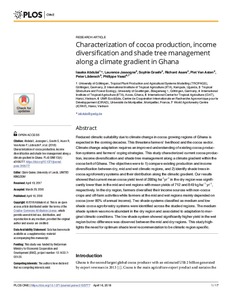| dc.contributor.author | Abdulai, Issaka |
| dc.contributor.author | Jassogne, Laurence T.P. |
| dc.contributor.author | Graefe, Sophie |
| dc.contributor.author | Asare, Richard |
| dc.contributor.author | Asten, Piet J.A. van |
| dc.contributor.author | Läderach, Peter |
| dc.contributor.author | Vaast, Philippe |
| dc.date.accessioned | 2019-12-04T11:19:16Z |
| dc.date.available | 2019-12-04T11:19:16Z |
| dc.date.issued | 2018 |
| dc.identifier.citation | Abdulai, Issaka, Jassogne, Laurence, Graefe, Sophie, Asare, Richard, Van Asten, Piet, Läderach, Peter, Vaast, Philippe. (2018) Characterization of cocoa production, income diversification and shade tree management along a climate gradient in Ghana, PLoS ONE 13(4): e0195777. |
| dc.identifier.issn | 1932-6203 |
| dc.identifier.uri | https://hdl.handle.net/20.500.12478/3433 |
| dc.description.abstract | Reduced climatic suitability due to climate change in cocoa growing regions of Ghana is expected in the coming decades. This threatens farmers’ livelihood and the cocoa sector. Climate change adaptation requires an improved understanding of existing cocoa production systems and farmers’ coping strategies. This study characterized current cocoa production, income diversification and shade tree management along a climate gradient within the cocoa belt of Ghana. The objectives were to 1) compare existing production and income diversification between dry, mid and wet climatic regions, and 2) identify shade trees in cocoa agroforestry systems and their distribution along the climatic gradient. Our results showed that current mean cocoa yield level of 288kg ha-1yr-1 in the dry region was significantly lower than in the mid and wet regions with mean yields of 712 and 849 kg ha-1 yr-1, respectively. In the dry region, farmers diversified their income sources with non-cocoa crops and off-farm activities while farmers at the mid and wet regions mainly depended on cocoa (over 80% of annual income). Two shade systems classified as medium and low shade cocoa agroforestry systems were identified across the studied regions. The medium shade system was more abundant in the dry region and associated to adaptation to marginal climatic conditions. The low shade system showed significantly higher yield in the wet region but no difference was observed between the mid and dry regions. This study highlights the need for optimum shade level recommendation to be climatic region specific. |
| dc.format.extent | 13(4): e0195777 |
| dc.language.iso | en |
| dc.publisher | Public Library of Science |
| dc.subject | Theobroma Cacao |
| dc.subject | Climate Change |
| dc.subject | Cambio Climatico |
| dc.subject | Climate Change Adaptation |
| dc.subject | Adaptación Al Cambio Climático |
| dc.subject | Production |
| dc.subject | Drought |
| dc.subject | Sequia |
| dc.subject | Agroforestry |
| dc.subject | Sistemas Agroforestales |
| dc.title | Characterization of cocoa production, income diversification and shade tree management along a climate gradient in Ghana |
| dc.type | Journal Article |
| dc.description.version | Peer Review |
| cg.contributor.crp | Climate Change, Agriculture and Food Security |
| cg.contributor.affiliation | International Center for Tropical Agriculture |
| cg.contributor.affiliation | International Institute of Tropical Agriculture |
| cg.contributor.affiliation | Centre de Coopération Internationale en Recherche Agronomique pour le Développement |
| cg.contributor.affiliation | World Agroforestry Centre |
| cg.coverage.region | Africa |
| cg.coverage.region | West Africa |
| cg.coverage.country | Ghana |
| cg.creator.identifier | Peter Läderach: 0000-0001-8708-6318 |
| cg.isijournal | ISI Journal |
| cg.journal | PLoS ONE |
| cg.howpublished | Formally Published |
| cg.accessibilitystatus | Open Access |
| local.dspaceid | 95360 |
| cg.identifier.doi | https://doi.org/10.1371/journal.pone.0195777 |

